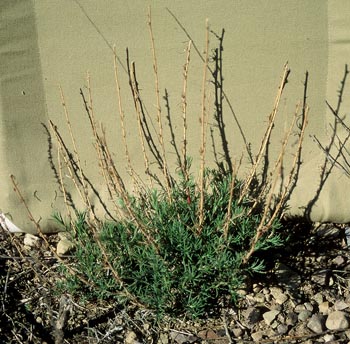Forage Kochia

Common Name(s):
Forage Kochia
Prostrate Summercypress
Scientific Name:
Bassia prostrata (L.) A.J. Scott
Scientific Name Synonyms:
Kochia prostrata (L.) Schrad.
Symbol:
BAPR5
Description:
Life Span: Perennial
Origin: Introduced
Season: Semi-Evergreen
Growth Characteristics: A long lived, semi-evergreen half-shrub that averages 1 to 3 feet tall at maturity, and germinates quickly in late February. It may live 10 to 15 years, developing an extensive root system, with a taproot up to 16 feet long.
Flowers/Inflorescence: Flowers in interrupted clusters. Flowers have appendages that are round, flat, or wing-like.
Fruits/Seeds: Seeds oval or round in outline. Fruit is a utricle. Seeds germinate well for up to 6 to 8 months after harvest.
Leaves: Leaves linear to thread-like.
Stems: Stems grow from a low woody base. The upper stems turn reddish brown and dry up after seed shatter. The lower stems stay green and succulent year-round.
Ecological Adaptions:
Forage kochia occurs in desert and semi-desert areas of Utah. Most success has been found in areas with high alkalinity. It benefits from grazing at 70% to 80% utilization. It sprouts and regrows after burning. Forage kochia does not tolerate flooding or soil with a water table.
Soils: Most common in alkaline clay soils. It is well adapted to a wider range of soils, including fine- to coarse-textured, shallow- to deep-gravelly to stony, and saline to alkaline. It seems to grow best on heavy textured soils. It is not well adapted to neutral or acidic soils.
Associated Species: Cheatgrass, bulbous bluegrass, halogeton.
Uses and Management:
Forage kochia has been seeded to improve plant community diversity, aesthetics, plant cover species richness, forage for livestock and wildlife, fire prevention, and soil stability. It suppresses or eliminates the invasion of alien annual weeds like cheatgrass, halogeton, Russian thistle, and medusahead rye. It is not highly invasive and does not spread aggressively into healthy plant communities. It does not compete well with perennial grasses.

